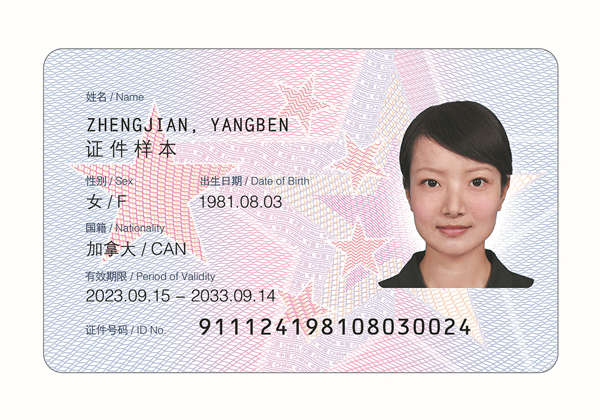Foreigners' ID card gets hi-tech revamp

A sample of the new version of the Foreign Permanent Resident ID Card. [Photo/China Daily]
A new version of the Foreign Permanent Resident ID Card will be officially launched and issued on Dec 1, incorporating new technology for better personal information protection and wider application scenarios, the National Immigration Administration said on Friday.
The administration said that enabling the new version of the card is a practical measure to ensure China's high-level openness to the world and enhance the digitalization of foreigners' management and services.
The new card is expected to improve the quality and efficiency of immigration management services and better serve overseas talent working, studying and living in the country.
After the launch, the current version of the document that is still valid can also be used simultaneously, and holders of the current version can apply for the new version at local exit-entry administration agencies as needed, said the NIA.
Mao Xu, director of the NIA's Department of Foreigners Management, said that the card can be used as a personal identity document in China. Cardholders can use it for various purposes such as accommodation registration and purchasing tickets, without the need to present their passport.
The NIA has comprehensively upgraded the card's machine-readable and visual-readable fields, improved technical specifications, optimized the layout and enhanced anti-counterfeiting features, he said.
The new card will be easily identified via visual reading and will facilitate the cardholders in more onsite application scenarios and on the internet, he said.
Mao noted that the NIA will work with other departments to accelerate the upgrading and transformation of information systems and facilities in various related industries and expand the scope of application of the new card.
According to the NIA, the new card expands the card number from 15 to 18 digits, incorporating information codes such as the foreigner identification code, nationality code and application location code. Each individual is assigned a unique number that remains unchanged throughout their lifetime.
Also, the design of the new card has also been optimized.
Chen Yongli, head of the NIA's Department of Information Technology, said that more advanced anti-counterfeiting technology has been adopted in the new card.
The new card has adjusted the chip storage structure and upgraded it to be compatible with the widely used identity card-reading machines in various sectors and departments, he said.
Jia Tongbin, deputy director of the NIA's Department of Foreigners Management, explained that the card allows its holder to enter and exit the Chinese border multiple times, without the need for additional visa procedures, when presented along with a valid passport.
It enables the cardholder to purchase tickets and use various modes of transportation such as airplanes, trains and ships within China. For accommodation in domestic hotels, the cardholder can use the card to complete the check-in process, Jia said.
When conducting financial transactions like banking, insurance and securities, and handling services including telecom, taxation and property registration, the card serves as a valid identification document, he said.
Furthermore, major internet platform applications and public and government service applications in China, such as the National Government Service Platform, 12306 Railway, 12123 Traffic Management, and Personal Income Tax have recognized and included the card as an acceptable form of identification, he added.



![9月6日[20230907-100556]_副本.jpg](http://subsites.chinadaily.com.cn/shanxi/yangquan/img/attachement/jpg/site48/20230907/16940658088291.jpg)

